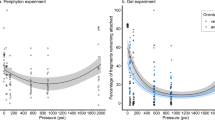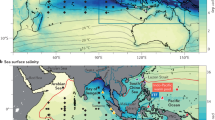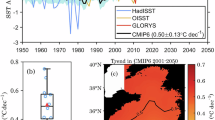Abstract
A SURVEY of the results of experiments performed in baths1 suggests that few men would live in water near freezing point for more than 30 min. and none for more than 1½ hr. Yet some people derive much pleasure and no harm from brief immersions in such water, and shipwrecked people are known to have survived after spending several hours in icy seas. Thus, Molnar1 has quoted a group of twenty-three people who all survived long immersion in the sea although experiments performed in baths suggested that this should have lowered their rectal temperatures to 24° C., and he was surprised to find in another report that three men who had no life-jackets could hold up their heads after 1 hr. in water at 4–7° C. Critchley2, moreover, has quoted an example of a man who survived after swimming for more than half a day in water at − 1.5°C. The following observations and calculations may explain this apparent contradiction.
This is a preview of subscription content, access via your institution
Access options
Subscribe to this journal
Receive 51 print issues and online access
$199.00 per year
only $3.90 per issue
Buy this article
- Purchase on SpringerLink
- Instant access to full article PDF
Prices may be subject to local taxes which are calculated during checkout
Similar content being viewed by others
References
Molnar, G. W., J. Amer. Med. Assoc., 131, 1046 (1946).
Critchley, McD., “Shipwreck-Survivors, a Medical Study” (J. and A. Churchill, London, 1943).
Glaser, E. M., J. Physiol., 109, 366 (1949).
DuBois, D., and DuBois, E. F., Arch. Intern. Med., 17, 863 (1916).
Burton, A. C., and Bazett, H. C., Amer. J. Physiol., 117, 36 (1936).
Hardy, J. D., and DuBois, E. F., “Temperature, its Measurement and Control in Science and Industry” (Symposium) (Reinhold, New York, 1941).
Winslow, C. E. A., Herrington, L. P., and Gagge, A. P., Amer. J. Physiol., 120, 1 (1937).
Burton, A. C., J. Nutrit., 9, 261 (1935).
Haldane, J. S., “Methods of Air Analysis” (C. Griffin and Co., London, 1912).
Spealman, C. R., Proc. Soc. Exp. Biol. N.Y., 60, 11 (1945).
Spealman, C. R., “Physiology of Heat Regulation and the Science of Clothing”, edit. by Newburgh, L. H. (W. B. Saunders, London, 1949).
Author information
Authors and Affiliations
Rights and permissions
About this article
Cite this article
GLASER, E. Immersion and Survival in Cold Water. Nature 166, 1068 (1950). https://doi.org/10.1038/1661068a0
Issue date:
DOI: https://doi.org/10.1038/1661068a0
This article is cited by
-
Human Immersion and Survival in Cold Water
Nature (1951)



